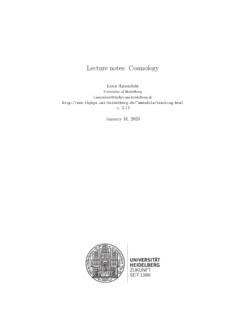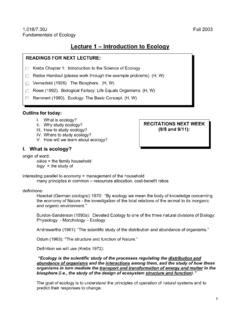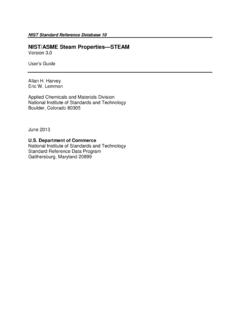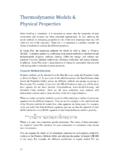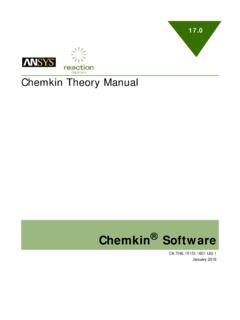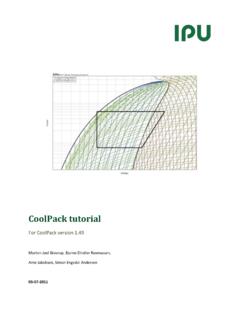Transcription of Theoretical Statistical Physics
1 HEIDELBERGUNIVERSITYDEPARTMENT OFPHYSICS ANDASTRONOMYT heoretical Statistical PhysicsProf. Ulrich SchwarzWinter term 2020/21 Last update: February 16, 2021 Lecture scripts by Ulrich SchwarzHeidelberg UniversityForewordThis script is written for the courseTheoretical Statistical Physicswhich is one of thecore courses for the master studies of Physics at Heidelberg University, although inpractise it is also attended by many bachelor students from the 5th semester. I have beengiving this course several times before, namely in the winter terms of 2012, 2015, 2017and 2020, and it is my experience that a script helps to correct the unavoidable errorsmade at the blackboard, to solidify the new knowledge through a coherent presentationand to prepare for the final exam. There exist many very good textbooks on statisticalphysics and the purpose of this script is soley to document my personal choice of therelevant Physics provides the basis for many important parts of Physics , includingatomic and molecular Physics , solid state Physics , soft matter Physics , biophysics, as-trophysics, environmental and socioeconomic Physics .
2 For example, you cannot under-stand the greenhouse effect or the cosmic microwave background without the Planckformula for the statistics of photons at a given temperature (black body radiation) orthe electrical conduction of solids without the concept of a Fermi sphere (the groundstate of a fluid of electrons at low temperature). Equally important, however, statisticalphysics provide the basis for our understanding of phase transitions, which are truelycollective effects and often do not depend much on microscopic details. As you willlearn in this course, at the heart of Statistical Physics is theart of counting, which is for-malized in the concept of a partition sum. The details of how this has to be done indifferent systems can be quite challenging, and thus it should not come as a surprisethat Statistical Physics is still a very active research area, continuously expanding intonew applications and developing new guiding principles and helpful books determined the design of this I completely agree with Josef Honerkamp who in his bookStatistical Physicsnotesthat Statistical Physics is much more than Statistical mechanics.
3 A similar notion is ex-pressed by James Sethna in his bookEntropy, Order Parameters, and Complexity. Indeedstatistical Physics teaches us how to think about the world in terms of is particularly relevant when one deals with complex systems and real world applications of Statistical Physics can also be found in data-intensive researchareas such as astrophysics, environmental Physics , biophysics, socioeconophysics andphysics of information (including machine learning). As instructive examples, considerthe models for the spread of rumours or viruses on networks, or the algorithms used forsegmentation and object recognition in image processing. If you investigate how thesemodels work, you will realize that they often relate to the Ising model for ferromagnets,arguably the most important model of Statistical Physics and an important subject forthis a course on Statistical Physics certainly has to make the connection to thermo-dynamics.
4 thermodynamics can be quite cubersome and hard to digest at times, soa pedagogical approach is highly appreciated by most students. Here I am stronglymotivated by the axiomatic and geometrical approach to thermodynamics as layed outin the beautiful bookThermodynamics and an introduction to Thermostatisticsby HerbertCallen. Historically thermodynamics developed as a phenomenological theory of heattransfer, but when being approached from the axiomatic and geometrical side, it be-comes the convincing and universal theory that it actually is. The book by Callen alsodraws heavily on the work by Edwin Jaynes on the relationship between statisticalphysics and information theory as pioneered by Claude Shannon. Although somehowdebated, this link shows once again that Statistical Physics is more than Statistical me-chanics. Information theory provides very helpful insight into the concept of entropy,which is the cornerstone of Statistical mechanics.
5 Recently this area has been revivedby the advent of stochastic thermodynamics , which shows that entropy is not only anensemble property, but can also be defined for single a comprehensive course on Statistical Physics should also include some numeri-cal component, because modern Statistical Physics cannot be practised without compu-tational approaches, as again nicely argued by Josef Honerkamp and James Statistical Physics is much more than thermodynamic equilibrium and iftime permits, a course on Statistical Physics should also cover some aspects of non-equilibrium Physics , for example the exciting recent developments in stochastic ther-modynamics. Although it is hard to fit all of these aspects into a one-semester course,some of them are included , these considerations might explain the structure of this script.
6 We start withan introduction to the concepts of probability theory, which should be useful also inother contexts than only Statistical mechanics. We then introduce the fundamental pos-tulate of equilibrium Physics , namely that each microstate is equally probable, leadingto the microcanonical ensemble and the principle of maximal entropy. We then discussthe canoncial and grandcanonical ensembles, when reservoirs exist for exchange of heatand particle number, respectively. We then apply these concepts to quantum fluids, inparticular the Fermi fluid ( electrons in a solid) and the Bose gas ( black bodyradiation with photons or the Debye model for crystal vibrations). These are interact-ing systems, but this is accounted for by the right way to count, not by investigatingdirect interactions. Yet, here we encounter our first phase transition, the Bose-Einsteincondensation.
7 We then introduce the concept of phase transitions emerging from directinteractions through the example of the Ising model. In particular, it is here that weintroduce one of the most important advances of Theoretical Physics of the 20th cen-tury, namely the renormalization group. We then continue to discuss phase transitions,now for complex fluids, starting with the van der Waals fluid and the virial expan-sion. We close with a discussion of thermodynamics , from which we see that statisticalphysics and thermodynamics essentially use the same formal structure, but that theycomplement each other in a unique manner: Statistical Physics focuses on the emer-gence of macroscopic properties from microscopic mechanisms, and thermodynamicson the macroscopic principles that necessarily have to be valid in the thermodynamiclimit of very large system size, independent of microscopic one should note some subjects which are not covered in the script due to spacereasons.
8 We do not cover kinetic and transport theories, which would also includethe Boltzmann equation. The very important subject of fluctuations and correlations(including the fluctuation-dissipation theorem) is mentioned only in passing. We alsocannot treat much out-of-equilibrium Physics here, in particular we do not cover Green-Kubo relations, Onsager s reciprocity theorem, Kramers-Kr nig relations or linear re-sponse theory. From the subject side, we will not have time to cover such interest-ing subjects as liquid crystals, percolation, disordered and glassy systems (includingthe replica method), nucleation, coarsening and Ostwald ripening, or the dynamics ofchemical reactions and , winter term 2020/21 Ulrich SchwarzContents1 Introduction to probability in Physics .. approach .. approach .. distributions and distribution function.
9 , marginal and conditional probabilities .. and covariance .. distribution .. distribution .. distribution .. Random walks .. Computation with random variables .. Addition of random variables .. Information entropy ..282 The microcanonical equilibrium .. and macrostates .. of states .. fundamental postulate .. conditions .. of state for ideal gas .. system .. model for specific heat of a solid .. elasticity of polymers .. Statistical deviation from average .. Foundation of the fundamental postulate ..573 The canonical distribution .. energy .. systems .. theorem .. gases .. heat of a solid .. body radiation ..864 The grandcanonical distribution .. potential .. gas .. adsorption onto a surface .. reactions ..985 Quantum versus bosons.
10 With occupation numbers .. ideal Fermi fluid .. ideal Bose fluid .. limit .. 1226 Ising .. 1d Ising model .. matrix .. of the Ising chain .. of the 2d Ising model .. Peierls argument .. 2d Ising model .. theory .. field theory for the Ising model .. Monte Carlo computer simulations of the Ising model .. 1517 Classical expansion .. virial coefficient .. construction .. phase transition .. functions .. 1678 structure .. principles .. and Gibbs-Duhem relations .. potentials and Legendre transformations .. relations .. of work and heat .. and irreversible processes .. engines .. reactions .. 1949 Non-equilibrium Statistical physics19910 Appendix: some useful relations between partial derivatives2021 Introduction to probability Probability in physicsClassical Physics (classical mechanics and electrodynamics) is deterministic, that meansthe governing equations (Newton s and Maxwell s equations, respectively) are differ-ential equations that have a unique solution once we know the initial conditions (andboundary conditions for the case of Maxwell s equations, which are partial differentialequations).
